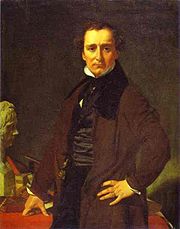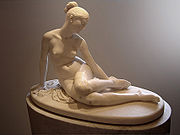
Lorenzo Bartolini
Encyclopedia

Italy
Italy , officially the Italian Republic languages]] under the European Charter for Regional or Minority Languages. In each of these, Italy's official name is as follows:;;;;;;;;), is a unitary parliamentary republic in South-Central Europe. To the north it borders France, Switzerland, Austria and...
sculptor
Sculpture
Sculpture is three-dimensional artwork created by shaping or combining hard materials—typically stone such as marble—or metal, glass, or wood. Softer materials can also be used, such as clay, textiles, plastics, polymers and softer metals...
who infused his neoclassicism
Neoclassicism
Neoclassicism is the name given to Western movements in the decorative and visual arts, literature, theatre, music, and architecture that draw inspiration from the "classical" art and culture of Ancient Greece or Ancient Rome...
with a strain of sentimental piety and naturalistic detail which led him furthermore in the future, while he drew inspiration from the sculpture of the Florentine Renaissance rather than the overpowering influence of Antonio Canova
Antonio Canova
Antonio Canova was an Italian sculptor from the Republic of Venice who became famous for his marble sculptures that delicately rendered nude flesh...
that circumscribed his Florentine contemporaries.
Biography
Bartolini was born in Vernio, near PratoPrato
Prato is a city and comune in Tuscany, Italy, the capital of the Province of Prato. The city is situated at the foot of Monte Retaia , the last peak in the Calvana chain. The lowest altitude in the comune is 32 m, near the Cascine di Tavola, and the highest is the peak of Monte Cantagrillo...
, Tuscany
Tuscany
Tuscany is a region in Italy. It has an area of about 23,000 square kilometres and a population of about 3.75 million inhabitants. The regional capital is Florence ....
.
After studying at the Florentine Academy, honing his skills and reputation as a modeller in alabaster, he went in 1797 to Paris
Paris
Paris is the capital and largest city in France, situated on the river Seine, in northern France, at the heart of the Île-de-France region...
, where he studied painting under Frédéric Desmarais, and afterwards sculpture under François-Frédéric Lemot
François-Frédéric Lemot
François-Frédéric Lemot was a French sculptor, working in the Neoclassical style.-Biography:Lemot was born at Lyon....
. The bas-relief Cleobis and Biton, with which he gained the second prize of the Academy in 1803, at once established his fame as a sculptor and gained for him a number of influential patrons. His bas-relief of the Battle of Austerlitz was among those executed for the column erected in Place Vendôme
Place Vendôme
Place Vendôme is a square in the 1st arrondissement of Paris, France, located to the north of the Tuileries Gardens and east of the Église de la Madeleine. It is the starting point of the Rue de la Paix. Its regular architecture by Jules Hardouin-Mansart and pedimented screens canted across the...
. He also executed many minor pieces for Vivant-Denon, besides portrait busts of the opera composers Méhul
Étienne Méhul
Etienne Nicolas Méhul was a French composer, "the most important opera composer in France during the Revolution." He was also the first composer to be called a "Romantic".-Life:...
and Cherubini
Luigi Cherubini
Luigi Cherubini was an Italian composer who spent most of his working life in France. His most significant compositions are operas and sacred music. Beethoven regarded Cherubini as the greatest of his contemporaries....
. His great patron, however, was Napoleon, for whom he executed a colossal bust, and who sent him, on the recommendations of his sister Elisa Baciocchi, to Carrara
Carrara
Carrara is a city and comune in the province of Massa-Carrara , notable for the white or blue-grey marble quarried there. It is on the Carrione River, some west-northwest of Florence....
in 1807, to direct the academy of sculpture, in spite of local opposition. Here he remained as the quasi-official portrait sculptor to the Buonapartes till after the fall of Napoleon. He then took up his residence in Florence
Florence
Florence is the capital city of the Italian region of Tuscany and of the province of Florence. It is the most populous city in Tuscany, with approximately 370,000 inhabitants, expanding to over 1.5 million in the metropolitan area....
, where he resided till his death.

Antonio Canova
Antonio Canova was an Italian sculptor from the Republic of Venice who became famous for his marble sculptures that delicately rendered nude flesh...
being taught at the Academy" limited his opportunities. His naturalistic and somewhat sentimental marble L'Ammostatore ("The Bird's-nest Stealer", 1820) took its inspiration from under-appreciated Quattrocento Florentine sculptors like Andrea Verrocchio. In his decade of impoverishment, supportive commissions came from foreigners; the funeral monument to Princess Sofia Zamoyski Czartoriski (died 1837) in Santa Croce, Florence's Westminster Abbey, is an anti-classical statement for naturalism. Two other Bartolini monuments in Santa Croce can be compoared with it; in the Capella Giugni is his monument to Carlotta Buonaparte (died 1839), but when the occasion required a more formal approach, as in the monument to Leone Battista Alberti
Leone Battista Alberti
Leon Battista Alberti was an Italian author, artist, architect, poet, priest, linguist, philosopher, cryptographer and general Renaissance humanist polymath...
, the result could be chilly. An outstanding commission came in 1830 from the sons of the Russian prince Nicola Demidoff, who had retired to Florence, to sculpt a monument, which is still to be seen in Piazza Demidoff, Florence. The commission's multiple figures took shape during Bartolini's last decades; it was completed by Bartolini's assistant Pasquale Romanelli.
His works are varied and include an immense number of portrait busts. The best are, perhaps, the group of Charity (1824), the Hercules and Lichas and Faith in God, commissioned by the widow of Giuseppe Poldi Pezzoli. His portrait statue of Macchiavelli took its place as his only commission among the long series of historical Florentine males provided for the empty exterior niches of the Uffizi
Uffizi
The Uffizi Gallery , is a museum in Florence, Italy. It is one of the oldest and most famous art museums of the Western world.-History:...
.
External links
- La Scultura Italiana: Lorenzo Bartolini (Italian)

